The Intel Skylake Mobile and Desktop Launch, with Architecture Analysis
by Ian Cutress on September 1, 2015 11:05 PM ESTThe Claims
As with any launch, there are numbers abound from Intel to explain how the performance and experience of Skylake is better than previous designs as well as the competition.
As with Haswell and Broadwell, Intel is implementing a mobile first design with Skylake. As with any processor development structure the primal idea is to focus on one power point as being the most efficient and extend that efficiency window as far in either direction as possible. During IDF, Intel stated that having an efficiency window from 4.5W to 91W is a significant challenge, to which we agree, as well as improving both performance and power consumption over Broadwell at each stage.
Starting at 4.5W, we spoke extensively with parts of Intel at IDF due to our Broadwell-Y coverage. From their perspective Broadwell-Y designs were almost too wide ranging, especially for what is Intel’s premium low-power high performance product, and for the vendors placing it in an ill-defined chassis far away from Intel’s recommended designs gave concern to the final performance and user experience. As a result, Intel’s guidelines to OEMs this generation are tightened so that the designers looking for the cheaper Core M plastic implementations can tune their design to get the best out of it. Intel has been working with a few of these (both entry Core M and premium models) to enact the user experience model.
Overall however, Intel is claiming 40% better graphics performance for Core M with the new Generation 9 (Gen9) implementation, along with battery saving and compatibility with new features such as RealSense. Because Core-M will find its way into products from tablets to 2-in-1s and clamshells, we’ve been told that the Skylake design should hit a home-run against the best-selling tablets in the market, along with an appropriate Windows 10 experience. When we get units in to review, we will see what the score is from our perspective on that one.
For the Skylake-Y to Skylake-U transition (and in part, Skylake-H), Intel is claiming a 60% gain in efficiency over Haswell-U. This means either 60% less active power during media consumption or 60% more CPU performance at the same power (measured by synthetics, specifically SPECint_base_rate2006). The power consumption metrics comes from updates relating to the Gen9 graphics, such as multi-plane overlay and fixed-function decoders, as well as additional power/frequency gating between the unslice and slices. We will cover this later in the review. The GPU itself, due to the new functionality, is claiming 40% better graphics performance for Core M during 3DMark synthetic tests.
While not being launched today, Intel’s march on integrated graphics is also going to continue. With the previous eDRAM parts, Intel took the crown for absolute IGP performance from AMD, albeit being in a completely different price band. With Skylake, the introduction of a 4+4e model means that Intel’s modular graphics design will now extend from GT1 to GT4, where GT4e has 72 execution units with 128MB of eDRAM in tow. This leads to the claim that GT4e is set to match/beat a significant proportion of the graphics market today.
Back in our Skylake-K review, we were perhaps unimpressed with the generational gain in clock-for-clock performance, although improved multi-threading and frequency ranges helped push the out-of-the-box experience. The other side of that performance is the power draw, and because Skylake is another mobile-first processor, the power aspect becomes important down in mobile devices. We will go through some of these developments to improve power consumption in this article.


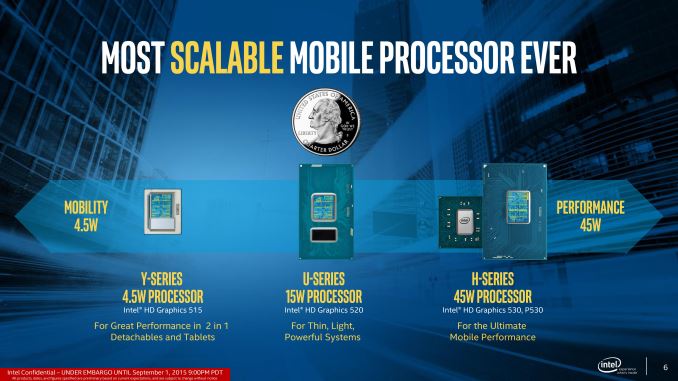
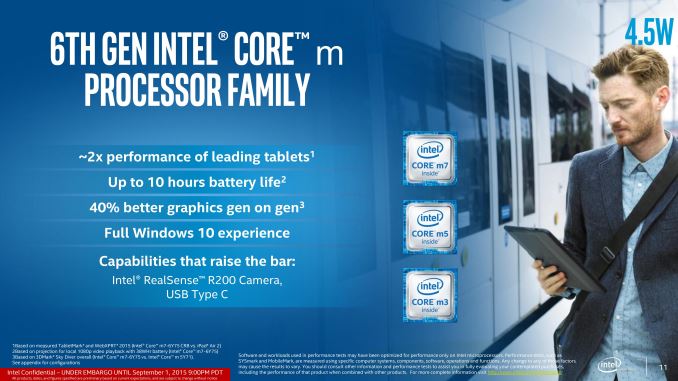
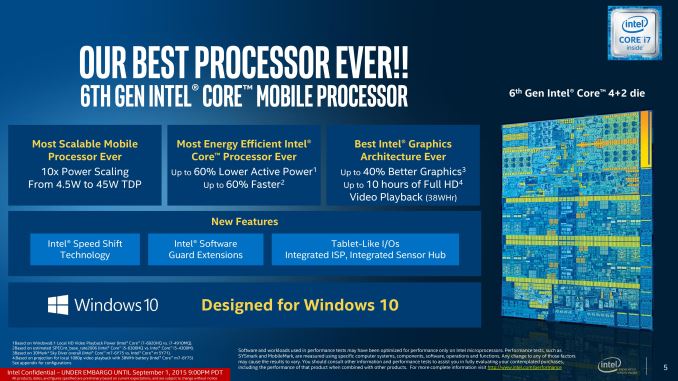
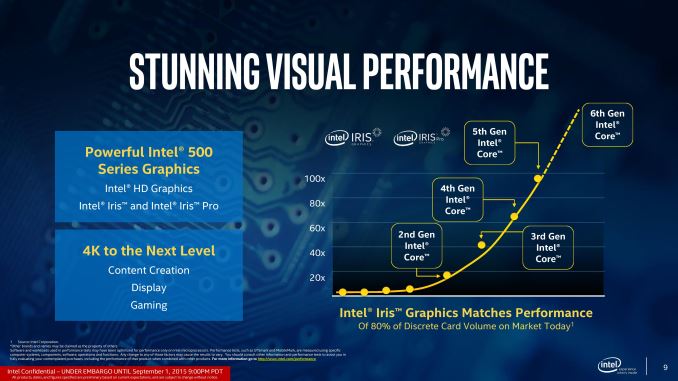
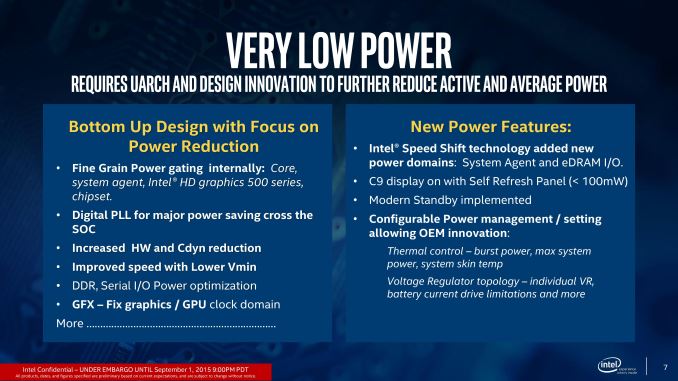








173 Comments
View All Comments
tipoo - Wednesday, September 2, 2015 - link
Two year old, you're only off by 8 years though.FourEyedGeek - Wednesday, September 9, 2015 - link
They were referring to XBox One, pay attention.Braincruser - Wednesday, September 2, 2015 - link
You are forgeting casual gamers and macs. Currently there is no reason in getting a GPU lower than GT950M in a laptop. And in this tier a laptop can be a very good console replacement with steam desktop mode and a wireless controller. Especially with a wi-di capable screen.I am talking about 7-800$ laptops that play games from 2012 and before at any resolution. and current games at 720p.
And at 950M you are at a gaming laptop level and are above 1000$ and this is a different category.
Jumangi - Wednesday, September 2, 2015 - link
Any sort of "casual gamer" will get far better value from a AMD A10/FX laptop. Good enough CPU power and far better GPU than anything Intel does.IanHagen - Wednesday, September 2, 2015 - link
Really? "Far better value"? First, the GPU isn't far better. It's slightly better.And that's it. Less processing power, more heat, less battery life and potentially heavier and bulkier laptop. Certainly a "casual gamer" will accept all this drawbacks for the sake of a handful extra FPS.Jumangi - Wednesday, September 2, 2015 - link
Yes it will be better and costs far less. These Intel chips cost way more. So go,ahead and think you will be gaming on these things without dropping a grand or more on the laptop.Notmyusualid - Wednesday, September 2, 2015 - link
Hmm, really?Did you see how Intel have come on recently in IGPs?
And some games are quite CPU dependent too.
I'll have to politely disagree with you.
retrospooty - Wednesday, September 2, 2015 - link
"Any sort of "casual gamer" will get far better value from a AMD A10/FX laptop"- I think you are overestimating AMD's GPU lead and underestimating the power and thermal advantages on the Intel side. I wouldn't buy an AMD chip in a laptop under any circumstances. They had some great ships back int he Thunderbird and Athlon64 days, but since ht eCOre2 came out in 2006 they are miles behind. They cant even see Intels dust at this point.
Jumangi - Wednesday, September 2, 2015 - link
No people keep Waaayy overestimating Intels integrated graphics. They still absolutely suck for any sort of gaming. If you want a somewhat capable laptop that can do at least decent mobile gaming AMD is still the only option unless you go with a discrete GPU. That's the fact.extide - Wednesday, September 2, 2015 - link
That's mostly because there haven't really been any Iris Pro SKU's for gaming laptops -- looks like that is going to change though..